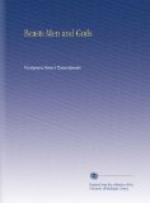The interior of the building was arranged with splendor. On the ground floor was the dining-room, furnished with richly carved, heavy blackwood Chinese tables and cabinets filled with porcelains and bronze. Above were two rooms, the first a bed-room hung with heavy yellow silk curtains; a large Chinese lantern richly set with colored stones hung by a thin bronze chain from the carved wooden ceiling beam. Here stood a large square bed covered with silken pillows, mattresses and blankets. The frame work of the bed was also of the Chinese blackwood and carried, especially on the posts that held the roof-like canopy, finely executed carvings with the chief motive the conventional dragon devouring the sun. By the side stood a chest of drawers completely covered with carvings setting forth religious pictures. Four comfortable easy chairs completed the furniture, save for the low oriental throne which stood on a dais at the end of the room.
“Do you see this throne?” said the Hutuktu to me. “One night in winter several horsemen rode into the monastery and demanded that all the Gelongs and Getuls with the Hutuktu and Kanpo at their head should congregate in this room. Then one of the strangers mounted the throne, where he took off his bashlyk or cap-like head covering. All of the Lamas fell to their knees as they recognized the man who had been long ago described in the sacred bulls of Dalai Lama, Tashi Lama and Bogdo Khan. He was the man to whom the whole world belongs and who has penetrated into all the mysteries of Nature. He pronounced a short Tibetan prayer, blessed all his hearers and afterwards made predictions for the coming half century. This was thirty years ago and in the interim all his prophecies are being fulfilled. During his prayers before that small shrine in the next room this door opened of its own accord, the candles and lights before the altar lighted themselves and the sacred braziers without coals gave forth great streams of incense that filled the room. And then, without warning, the King of the World and his companions disappeared from among us. Behind him remained no trace save the folds in the silken throne coverings which smoothed themselves out and left the throne as though no one had sat upon it.”
The Hutuktu entered the shrine, kneeled down, covering his eyes with his hands, and began to pray. I looked at the calm, indifferent face of the golden Buddha, over which the flickering lamps threw changing shadows, and then turned my eyes to the side of the throne. It was wonderful and difficult to believe but I really saw there the strong, muscular figure of a man with a swarthy face of stern and fixed expression about the mouth and jaws, thrown into high relief by the brightness of the eyes. Through his transparent body draped in white raiment I saw the Tibetan inscriptions on the back of the throne. I closed my eyes and opened them again. No one was there but the silk throne covering seemed to be moving.




